As the world spins deeper into the digital age, one medium quietly resists the tide of data. For many, putting down the silicon addiction and rejoining the analog feels impossible – but you’d be surprised how thrilling it is to roll dice instead of scroll feeds. All it takes is one game to rekindle the spark, and that spark is spreading fast. The return to tactile, face-to-face play isn’t nostalgia – it’s evolution.
The Great Digital Hangover
One board. Five friends. Zero save files.
Screens are everywhere – phones, PCs, consoles, even fridges. But somewhere between the fiftieth season pass and yet another patch note, promising “balance,” something snapped. Players stopped craving pixels and started craving presence.
We’re in the middle of a strategy renaissance, and it’s made of cardboard, not code.
Complexity That Doesn’t Apologize
Modern board games aren’t the dusty Monopoly sets your grandparents argued over. They’re mechanical symphonies – Scythe, Everdell, Frostpunk, Ark Nova – each one proof that analog strategy has evolved beyond “roll and move” into tactile storytelling.
The difference?
Board games demand patience. They make you think three turns ahead, not three microtransactions deep.
They ask, “Can you outwit your friends?” not “Can your GPU handle this patch?” Even video gamers – the twitch-reflex elite – are realizing that physical strategy scratches an itch digital ones can’t. You can’t patch human psychology. You have to outthink it.
Community Over Connectivity
Video games promised us social worlds. What we got were chat bans, lag spikes, and squadmates named “420NoScope69.”
Board games quietly did what MMOs never could – they built real communities. Face-to-face interactions.
There’s something beautifully primal about leaning over a table, seeing someone’s bluff form before they even open their mouth. Board games turn every match into an interaction, not a transaction.
That’s why local game nights and cafés are booming; people can feel the strategy renaissance. While digital spaces argue about netcode, analog ones are filled with laughter, betrayal, and strategy so sharp you can feel it cut.
Humans crave eye contact and consequence. In a board game, when you lose, you can’t rage-quit. You shake hands and plan the rematch.
Designers as Artists, Not Algorithm Farmers
In the digital world, design is often dictated by retention metrics and quarterly profits. In the board game world, designers like Stonemaier Games, Mindclash Games, and Awaken Realms are pushing design as art.
You don’t need a day-one patch to fix Scythe. You don’t need a loot box to enjoy Frostpunk.
All you need is a table, a few friends, and a willingness to get your ego bruised. These designers aren’t optimizing for clicks – they’re crafting experiences that end.
Nemesis is a trilogy of board games with an in-depth story that concludes without harming replayability. Ironically, that’s what makes it unforgettable.
The Tactile Revolution
There’s something deeply satisfying about holding your empire in your hands – the weight of metal coins, the texture of miniatures, the satisfying clack of a meeple landing on the board.
In an era of digital burnout, those small, tangible joys feel revolutionary. They ground us.
We’re reminded that play doesn’t have to exist behind glass. The board game industry is projected to rise to $30 billion within the next four years.
And that’s the quiet magic of this renaissance – it’s not a rebellion against technology; it’s a recalibration of joy.
The Table Is the New Arena
The modern strategy game doesn’t need a console war. It already won where it matters – in attention, emotion, and memory.
While AAA studios chase engagement metrics, the humble tabletop reminds us that games don’t need to be endless to be meaningful. They just need to be shared.
So yes, the renaissance is real.
And it’s happening every time someone opens a box, sets up a board, and says,
“Alright… your turn.”
To see some of the reasons we play these games, read my reviews of:






